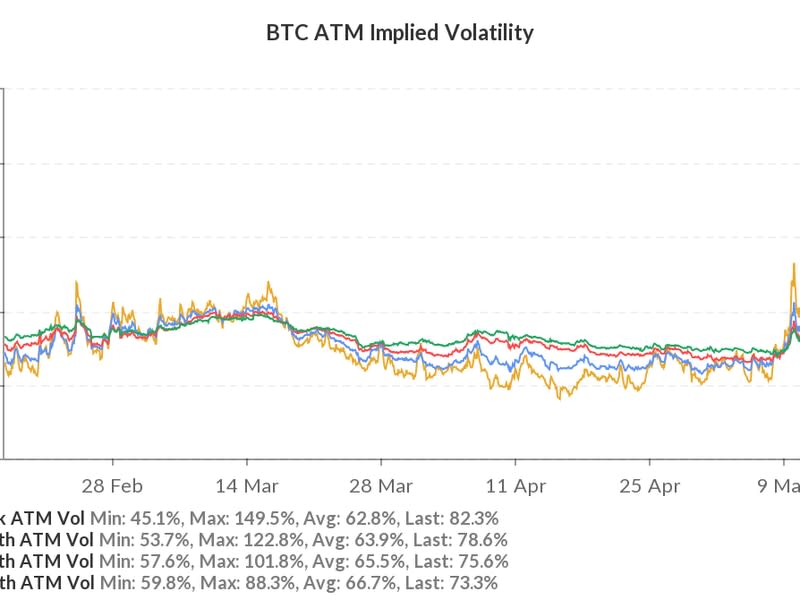Market Wrap: Cryptos Mixed as Volatility Fades, Traders Expect Weak Recovery
Don't miss CoinDesk's Consensus 2022, the must-attend crypto & blockchain festival experience of the year in Austin, TX this June 9-12.
Bitcoin (BTC) was roughly flat on Monday, while some alternative cryptos (altcoins) underperformed, indicating a lower appetite for risk among traders.
LUNA, Terra's governance token, declined by 18% over the past 24 hours, compared with a 6% drop in GALA and a 5% decline in AVAX and DOT over the same period. Typically, alts decline more than bitcoin in down markets because of their higher risk profile.
Still, the uptick in trading volume during last week's sell-off coupled with fading volatility could point to a brief upswing in crypto prices.
Just launched! Please sign up for our daily Market Wrap newsletter explaining what happens in crypto markets – and why.
Technical indicators suggests a weak price recovery for bitcoin, which requires another weekly close above $30,000 to encourage buying activity. Still, the recovery could fade at around $33,000-$35,000 because of negative momentum signals on the charts.
Meanwhile, Terraform Labs CEO Do Kwon released a “revival plan” to save the Terra network after last week’s meltdown. Kwon proposed forking Terra into a new chain without terraUSD (UST). The plan could go into effect if token holders approve it. Read more here.
During last week's UST de-peg, "other major stablecoins such as USDC, BUSD and DAI experienced a 1% to 2% premium as investors moved toward assets they perceived were less at risk of contagion," Glassnode wrote in a blog post. That suggests, for now, that risks surrounding UST have been contained.
Latest prices
●Bitcoin (BTC): $29,727, −1.98%
●Ether (ETH): $2,017, −3.39%
●S&P 500 daily close: $4,010, −0.36%
●Gold: $1,823 per troy ounce, +0.88%
●Ten-year Treasury yield daily close: 2.88%
Bitcoin, ether and gold prices are taken at approximately 4pm New York time. Bitcoin is the CoinDesk Bitcoin Price Index (XBX); Ether is the CoinDesk Ether Price Index (ETX); Gold is the COMEX spot price. Information about CoinDesk Indices can be found at coindesk.com/indices.
Uptick in trading activity
Bitcoin's average trading volume last week rose toward its highest level since January. That happened during a time of extreme bearish sentiment.
Trading volume declined over the past weekend, but remains elevated – almost twice as high the average volume levels recorded in April, according to Arcane Research.
Still, in the futures market, bitcoin's open interest, or the total number of derivatives contracts outstanding on the Chicago Mercantile Exchange, continues to decline from its recent peak on March 28. That suggests the recent sell-off emanated from trading activity in the spot market rather than from leveraged traders in the futures market, although liquidations have accelerated the downward price moves.

Bitcoin's implied volatility also remains elevated following last week's sell-off. Further, intraday volatility reached its highest level since May of last year, according to Arcane Research.
"The key contributor to surging intraday volatility tends to be massive destabilizing effects in derivatives with leveraged positions unwinding, causing knock-off effects in all associated markets," Arcane wrote.
Typically, volatility spikes are short-lived, especially if price declines stabilize. Some traders remain cautious because of the weak recovery in crypto and equity prices following last week's sell-off.
QCP Capital, a Singapore-based crypto trading firm, stated that it intends to keep long volatility positions open in anticipation of choppy markets, according to a recent Telegram announcement. The firm is watching for news on the fallout from the Terra stablecoin debacle, which could be a source of additional volatility in the future.
Still, others are looking for opportunities to fade the spike in volatility. "In the short term, spot prices have likely bottomed out while option volatility likely peaked," Greg Magadini, CEO of Genesis Volatility, wrote in a blog post on Sunday.
"Should prices find stability and bounce violently higher, fading the skew is a prime volatility trade," Magadini wrote, referring to the anticipated decline in the relative volatility of put options versus call options.


Altcoin roundup
Morgan Stanley warns about NFTs: The bank said non-fungible tokens (NFTs) may be the next part of crypto requiring re-evaluation after DeFi (decentralized finance) tokens and stablecoins saw liquidations, “as it is becoming clearer that all the elevated prices were traded on speculation, with limited real user demand.” Read more here
UST reserves evaporates: Luna Foundation Guard, the nonprofit that was supposed to save Terra’s stablecoin UST in a crisis, broke its multiday silence and confirmed that its reserve that was once $3 billion mostly held in bitcoin has dwindled to $100 million. As UST fell into a death spiral, LFG said that it sold the reserve to restore UST’s peg and denied allegations that it bailed out insiders with it. Earlier, blockchain analytics firm Elliptic tracked the money to major exchanges Gemini and Binance. Read more here
Investors flee stablecoins: As the market tries to stomach crypto’s Lehman Brothers moment after UST’s implosion, most stablecoins saw heavy outflows as investors lost confidence. Tether (USDT) has lost $8 billion in market cap in May, and the supply of dai (DAI) dropped 20% and frax (FRAX) almost halved, according to CoinMarketCap data. Meanwhile, the Fantom blockchain’s algorithmic stablecoin, Deus Finance's dei, lost its peg during the day. Read more here
Relevant insight
Listen 🎧: The CoinDesk Markets Daily podcast team is back to discuss what a recent bill on crypto mining might means for New York’s economy.
Crypto Funds Saw Year's Highest Inflows as Terra Crisis Crashed Markets: Some $274 million flowed into digital asset funds as investors bought the dip amid a broad crypto-market sell-off triggered by Terra's turmoil.
Portugal Makes U-Turn on Cryptocurrency Tax: Reversing its previous hands-off stance, the nation will impose taxes on the exchange and sale of cryptocurrencies.
German Regulator Calls for New DeFi Laws: BaFin's Birgit Rodolphe cites the potential for fraud and investor losses.
Japan’s Nomura Said to Launch Crypto Unit With DeFi and NFTs on Menu: The Japanese investment bank carried out its first cryptocurrency derivatives trades last week.
ECB’s Panetta: Digital Euro Could Come Out Within 4 Years: Peer-to-peer payments could be a first test case, though no final decision has been made yet on whether to have a digital euro.
Nigeria’s SEC Affirms All Digital Assets Are Securities in New Rulebook: Rules look to clarify crypto’s role in the economy by providing a regulatory framework.
Indian Central Bank Says Cryptos Could Lead to ‘Dollarization’ of Economy: RBI officials said cryptocurrencies could undermine the central bank's capacity to regulate the flow of money.
Celsius Network Files Draft S-1 Form to Take Its Mining Unit Public: The filing is expected to become effective after the SEC completes its review process, subject to market and other conditions.
US and EU Look to Blockchain to Track Greenhouse Gas Emissions: The U.S.-EU Trade and Technology Council’s Climate and Clean Tech working group announced its aims in a joint document published Monday.
Other markets
Most digital assets in the CoinDesk 20 ended the day lower.
Biggest Gainers
Asset | Ticker | Returns | DACS Sector |
|---|---|---|---|
Algorand | +2.6% |
Biggest Losers
Asset | Ticker | Returns | DACS Sector |
|---|---|---|---|
Internet Computer | −6.9% | ||
Filecoin | −6.7% | ||
Polkadot | −6.3% |
`
Sector classifications are provided via the Digital Asset Classification Standard (DACS), developed by CoinDesk Indices to provide a reliable, comprehensive and standardized classification system for digital assets. The CoinDesk 20 is a ranking of the largest digital assets by volume on trusted exchanges.

 Yahoo Movies
Yahoo Movies 
